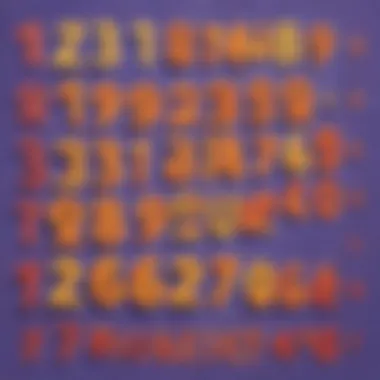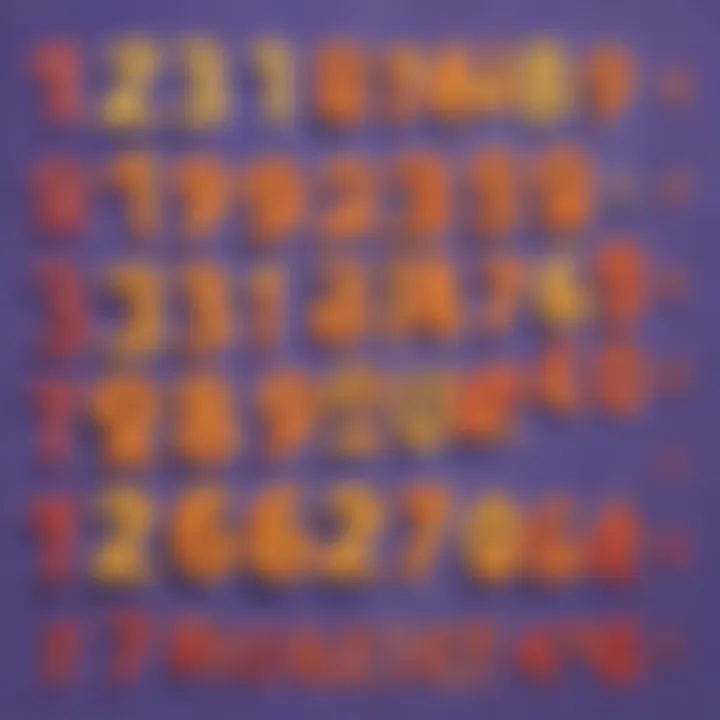Mastering Division of Mixed Numbers and Fractions


Intro
Dividing mixed numbers by fractions may seem complex at first. However, it is essential to grasp this concept for effective arithmetic skills. Mixed numbers are composed of a whole number and a fraction. For example, the mixed number 2 1/3 consists of the whole part 2 and the fractional part 1/3. In contrast, a fraction like 3/4 represents a part of a whole. Understanding how to manipulate these numbers together is a vital part of math education.
This article breaks down the process into manageable steps. First, we will discuss how to convert mixed numbers into improper fractions. Then, the focus will shift to how to divide these improper fractions. Through clear examples, it aims to elucidate the operations involved and boost confidence in students. By mastering these skills, students are better equipped for advanced mathematics.
Creative Activities
Engaging students with creative activities can foster a deeper understanding of dividing mixed numbers by fractions. Here are some ideas to make learning enjoyable and effective.
Craft Ideas
- Fraction Charts: Create charts that display different fractions. This visual aid can help students understand parts of a whole.
- Mixed Number Models: Use objects like blocks or clay to model mixed numbers. Students can physically combine whole numbers with fractions, showcasing the concept visually.
Step-by-Step Guides
- Create a Fraction Chart:
- Make Mixed Number Models:
- Collect supplies like paper, markers, and rulers.
- Build a chart that lists different fractions such as 1/2, 1/3, and 3/4.
- Gather similar-sized blocks.
- Assemble stacks to demonstrate mixed numbers and encourage students to express these in fraction form.
Educational Value
These activities not only stimulate creativity but also reinforce understanding. When students actively engage with the material, they are more likely to remember the concepts. Crafting tangible models provides a concrete representation of abstract mathematical ideas. This method can help bridge the gap between theoretical and practical applications of mathematics.
Epilogue
By embracing creative activities, young learners can gain better insight into dividing mixed numbers by fractions. It makes the learning experience enjoyable while also being educational. Engaging in these activities fosters curiosity and promotes a more thorough understanding of mathematical concepts.
Intro to Mixed Numbers and Fractions
Understanding mixed numbers and fractions is fundamental in mathematics. While often overlooked, these concepts form the building blocks for more complex arithmetic operations. Recognizing how to work with these numbers effectively is essential not only for academic success but also for real-life applications. By grasping the definitions and significance of mixed numbers and fractions, learners can approach division and other mathematical tasks with confidence and clarity.
Definition of Mixed Numbers
A mixed number is a combination of a whole number and a proper fraction. For example, the mixed number 2 3/4 consists of the whole number 2 and the fraction 3/4. Mixed numbers are often used in everyday situations, such as cooking or measuring, where whole units and parts of a unit are expressed together. Knowing how to identify and work with mixed numbers is crucial when performing further calculations, such as division or addition with fractions.
Definition of Fractions
A fraction represents a part of a whole. It consists of two numbers: a numerator and a denominator. The numerator indicates how many parts are being considered, while the denominator shows the total number of equal parts. For instance, in the fraction 3/5, 3 is the numerator, and 5 is the denominator. Fractions can exist in simple forms, like 1/2, or as improper fractions, such as 7/4, where the numerator is greater than the denominator. Understanding fractions is vital, as they are commonly used in both academic settings and practical life situations.
Importance in Mathematics
Mixed numbers and fractions play a critical role in mathematics. They are not only essential for basic arithmetic but also for more advanced concepts in algebra and geometry. Dividing mixed numbers by fractions is a common task in various mathematical problems. Mastering this skill improves numerical fluency, enhances problem-solving abilities, and cultivates mathematical reasoning. Furthermore, a strong foundation in these areas promotes confidence in managing more intricate mathematical concepts as the learner progresses. Familiarity with fractions also helps develop an understanding of ratios and proportions, which are pivotal in many fields, including science, economics, and data analysis.
"Understanding the basics of mixed numbers and fractions is not just a mathematical skill; it’s a tool for engaging with the world around us."
Converting Mixed Numbers to Improper Fractions
In mathematics, converting mixed numbers to improper fractions is an essential step. A mixed number contains both a whole number and a fraction, while an improper fraction has a numerator larger than the denominator. This conversion is critical for performing operations like division or multiplication involving mixed numbers. If students grasp this concept, they will find many arithmetic processes easier.
Understanding Improper Fractions


An improper fraction has a unique structure that showcases its utility in mathematical calculations. Its numerator exceeds its denominator, meaning it represents a value greater than one whole. This form is particularly helpful when adding or subtracting fractions, as it allows for simpler operations. Properly understanding improper fractions ensures that students can execute calculations more smoothly during more complex problem-solving.
Conversion Process Explained
The process of converting a mixed number to an improper fraction consists of three straightforward steps. Each of these components plays a vital role in ensuring the accuracy of the conversion.
Identify Whole Number Part
The first step involves extracting the whole number component of the mixed number. This part contributes to the overall value of the mixed number and is crucial for the conversion. By isolating the whole number, students can easily incorporate it into the final calculation. Recognizing the whole number part helps to clarify the fraction's relationship with the whole value, making it a beneficial choice in the conversion process.
Its significance lies in providing the initial whole value that will become part of the new improper fraction.
Multiply by Denominator
Next, it is necessary to multiply the whole number by the denominator of the fractional part. This action transforms the whole number into a form compatible with the fraction. The key characteristic of this step is that it scales the whole value appropriately, ensuring that the conversion maintains accuracy. As students multiply, they enhance their understanding of how whole numbers interact with fractions. The advantage here is that it sets the stage for the final step of the conversion. However, care must be taken to avoid arithmetic errors that could lead to incorrect results.
Add Numerator
The final step is to add the numerator of the fraction to the product obtained from multiplying the whole number by its denominator. This additive process produces the new numerator for the improper fraction. By adding the numerator, students see how both components of the mixed number come together. It demonstrates that the improper fraction maintains the equivalent value of the original mixed number. The unique feature of this step is how it blends both the whole part and the fractional part into one coherent number, thus providing clarity in operations that follow.
Examples of Conversion
To solidify understanding and illustrate the process, practical examples serve as a valuable resource. By working through a few conversions, students can see how these steps apply in real situations.
For instance, take the mixed number 2 3/4. First, identify the whole number, which is 2. Multiply it by the denominator, 4, resulting in 8. Finally, add the numerator, 3, yielding a final improper fraction of 11/4.
Through examples, learners recognize the transformation from mixed numbers into improper fractions and appreciate the method's efficiency.
Ultimately, mastering this conversion paves the way for a deeper understanding of arithmetic operations involving mixed numbers.
Understanding Division of Fractions
Dividing fractions might seem complicated at first, but it is a crucial aspect of arithmetic that lays the groundwork for understanding more advanced mathematical concepts. In this article, we focus on Understanding Division of Fractions because it directly affects how students will resolve scenarios involving mixed numbers and fractions. Mastering this topic allows learners to develop confidence and precision in their mathematical skills.
When fractions are involved, there are unique characteristics to be aware of. The operation itself varies significantly from typical whole number division. Understanding these unique aspects will help learners perform calculations accurately, which is essential when it comes to dividing mixed numbers by fractions and enhancing overall numeracy skills.
Basic Rules of Dividing Fractions
Before diving into mixed numbers, it's essential to grasp the basic rules of dividing fractions. Here are the fundamental points to remember:
- Keep the first fraction: The fraction that you start with remains unchanged.
- Change the division sign to multiplication: Division is not the operation we directly perform; we flip it into a multiplication task.
- Convert the second fraction: The fraction you are dividing by becomes its reciprocal, which means you swap its numerator and denominator.
For example, if we have to divide 1/2 by 1/4, we rewrite it as:
- Keep the first fraction: 1/2
- Change to multiplication: 1/2 × ?
- Convert the second fraction: 1/4 becomes 4/1
So, the operation becomes: 1/2 × 4/1 = 4/2 = 2. This method is simple yet effective for finding solutions for fraction division questions.
Using the Reciprocal
Utilizing the reciprocal is the cornerstone of dividing fractions. When dividing fractions, the necessity to switch to the reciprocal allows for a clear mathematical pathway to a solution. This concept is particularly important when working with mixed numbers, as it simplifies the process significantly.
To illustrate this further, let's examine a fraction division that calls for the reciprocal:
- Consider the scenario of dividing 3/5 by 2/3. To apply the rule, we first transform this into:3/5 ÷ 2/3 = 3/5 × 3/2.


In this step, by turning division into multiplication with the reciprocal, we can multiply directly. The result will be:
- Multiply numerators: 3 × 3 = 9
- Multiply denominators: 5 × 2 = 10
- Thus, 3/5 ÷ 2/3 = 9/10.
Understanding the reciprocal empowers learners to navigate complex equations with ease.
In summary, knowledge of dividing fractions and utilizing the reciprocal forms the backbone of succeeding in more complex operations, especially when involving mixed numbers. Mastery of this section will enhance students' ability to engage with mathematics effectively.
The Procedure for Dividing Mixed Numbers by Fractions
Dividing mixed numbers by fractions is a crucial mathematical operation that plays an important role in various real-world scenarios. This procedure enables learners to navigate through complex arithmetic with more confidence. By comprehending how to effectively divide mixed numbers by fractions, one can deepen their understanding of broader mathematical concepts. This section elucidates the step-by-step process involved, ensuring clarity and comprehension for the reader.
Step-by-Step Instructions
Convert Mixed Number into Improper Fraction
Converting a mixed number into an improper fraction is essential in the process of division. This conversion simplifies the calculations, as improper fractions are easier to work with when performing various operations. The key characteristic of this conversion is that it combines both the whole number and the fractional part into a single fraction, making it straightforward during calculations.
This method is particularly beneficial because it removes complexity from division tasks. By having a singular entity to manipulate, students can focus on the division process without getting sidetracked by a mixed number's dual nature. However, a potential disadvantage might include the initial confusion some might face when first learning this conversion method. Once mastered, it simplifies future math problems significantly.
Change the Division to Multiplication
After converting the mixed number into an improper fraction, the next step is changing the division problem into multiplication. This step involves using a reciprocal of the fraction being divided by. The key characteristic of this approach is that it allows learners to apply a more familiar operation, multiplication, instead of division.
Changing division to multiplication can significantly enhance comprehension. Multiplication offers a direct way to find the product, helping students visualize mathematical relationships more easily. One unique feature of this method is its application of reciprocal principles, which can be somewhat confusing for new learners. Yet, this confusion can be mitigated with ample practice, benefiting those who wish to perform division tasks more efficiently.
Multiply by the Reciprocal
To finalize the division of mixed numbers by fractions, the next step involves multiplying by the reciprocal of the divisor. The reciprocal is simply a fraction flipped over. This step cements the procedure, as it transforms the earlier division into an equivalent multiplication scenario. The key characteristic of this step is its role in simplifying the division process, as multiplying fractions is often more intuitive.
This method is widely considered a beneficial approach because it can be applied across various types of fraction division problems, making it versatile. However, one disadvantage could be that learners must remember how to find the reciprocal, which can pose an additional challenge. Still, once they are comfortable with reciprocals, this process becomes a fluid part of their mathematical toolkit.
Simplifying the Result
After performing the multiplication, it is essential to simplify the result. Simplifying involves reducing the fraction to its simplest form, making it easier to interpret and use in further calculations. This step ensures that the final answer is presented clearly and concisely. Understanding how to simplify also reinforces learners' grasp of fractions and mixed numbers, enhancing their mathematical literacy.
Practical Examples
Practical examples are essential for conveying the principles of dividing mixed numbers by fractions. These examples not only illustrate the procedural steps discussed earlier but also allow readers to visualize and apply the concepts in real-world situations. Engaging with practical problems enhances comprehension and retention, especially for elementary school children who may struggle with abstract numerical concepts.
In presenting examples, it is important to break each problem down into manageable, understandable components. This approach clarifies the division process and reinforces the understanding of mixed numbers and fractions. Moreover, showing common mistakes can provide valuable insight into frequent misunderstandings. By reviewing practical examples, readers can develop greater confidence in their math skills and are better prepared to tackle similar problems independently.
Example One: Step-by-Step Breakdown
Let’s consider the mixed number 2 1/2 divided by the fraction 3/4. Here’s how to work through the example step-by-step:
- Convert the Mixed Number to an Improper Fraction: First, we convert 2 1/2 into an improper fraction. We multiply the whole number 2 by the denominator 2, yielding 4. Adding the numerator 1 gives us 5, thus 2 1/2 = 5/2.
- Change the Division to Multiplication: Next, we change the division by the fraction 3/4 into multiplication by its reciprocal, which is 4/3. Therefore, we rewrite the problem as 5/2 * 4/3.
- Multiply the Improper Fraction by the Reciprocal: We multiply the numerators together (5 * 4 = 20) and the denominators together (2 * 3 = 6). This gives us 20/6.
- Simplifying the Result: Finally, we simplify 20/6 by dividing both the numerator and denominator by their greatest common divisor, which is 2. This results in 10/3, or as a mixed number, 3 1/3.
The complete calculation neatly illustrates the process, reinforcing the methods learned in earlier sections.
Example Two: Another Perspective
Now, let's take a different mixed number for practice. We will divide 3 3/4 by 1/2. Here’s the approach broken down:


- Convert the Mixed Number to an Improper Fraction: Convert 3 3/4 into an improper fraction. Multiply 3 by 4 to get 12, and add 3, resulting in 15/4.
- Change the Division to Multiplication: Transform the division of 1/2 into multiplication by 2/1. We can rewrite the equation as 15/4 * 2/1.
- Multiply the Improper Fraction by the Reciprocal: This gives us 15 * 2 = 30 as the numerator and 4 * 1 = 4 as the denominator, resulting in 30/4.
- Simplifying the Result: When simplifying 30/4, divide both the numerator and denominator by 2, which simplifies to 15/2. As a mixed number, this is 7 1/2.
Through these examples, readers can see multiple instances of the same process, reinforcing their understanding.
Common Mistakes to Avoid
While dividing mixed numbers by fractions, several common mistakes can occur. Being aware of these pitfalls can help students avoid them:
- Forgetting to Convert: Often, students might forget the vital step of converting the mixed number into an improper fraction. This could lead to errors in subsequent calculations.
- Incorrect Use of Reciprocals: Some learners struggle with remembering to use the reciprocal of the divisor fraction. Misapplying this can yield completely wrong answers.
- Skipping Simplification: After obtaining a result, students sometimes fail to simplify the fraction. Poor attention to this detail can leave solutions in their less usable form.
- Errors in Basic Arithmetic: Simple mistakes in multiplication or addition can lead to incorrect final answers, underscoring the importance of careful calculation.
Paying attention to these mistakes helps solidify comprehension and builds confidence for tackling similar problems in the future.
Visual Aids for Understanding
Visual aids play a significant role in grasping the concept of dividing mixed numbers by fractions. For many learners, abstract mathematical ideas can seem intimidating. Visual representations help to bridge this gap. They simplify complex processes, making them more relatable and accessible. When students see diagrams, models, or interactive tools, they can often understand better than through text alone.
The benefits of using visual aids in teaching math are manifold. First, they cater to various learning styles. Some students are visual learners, preferring to see information represented graphically. Second, they allow for immediate understanding of relationships between numbers, making it easier to see how the components of mixed numbers and fractions interact during division. Lastly, visuals can make learning more engaging. A diagram or model captures attention and encourages active participation.
In summary, visual aids are not just supplementary tools; they are fundamental in enhancing understanding of dividing mixed numbers by fractions. They foster clarity, engagement, and retention of mathematical concepts.
Using Diagrams and Models
Creating a model, such as using physical objects like fraction tiles or shapes, also aids understanding. By manipulating these objects, learners can physically see how one fraction divides another, enhancing the overall comprehension. Breaking down the division into smaller parts can help students grasp the iterative nature of the process.
Interactive Tools and Resources
Interactive tools and resources provide additional layers of engagement when learning to divide mixed numbers by fractions. Online resources such as educational websites or math games offer dynamic experiences where learners can practice this operation in a simulated environment. These tools often incorporate instant feedback, which helps reinforce the concepts as students practice.
Moreover, platforms that simulate problems allow learners to visualize the step-by-step solutions. These interactive experiences cater to various learning preferences and enhance retention. They combine traditional learning with modern technology, making math more appealing to younger audiences.
Review and Practice Problems
By revisiting the core ideas, readers can ensure they have grasped the basics of mixed numbers, improper fractions, and the significant role of reciprocal numbers in division. The importance of thorough practice can’t be understated; it prepares students for various arithmetic operations they may encounter later in their education.
Here are some specific elements to consider when reviewing and practicing:
- Reinforcement: Revisiting key concepts helps solidify understanding.
- Skill Development: Engaging with practice problems enhances competence in applying concepts.
- Confidence Building: Recognizing and correcting mistakes builds confidence in mathematical abilities.
"Practice creates a solid foundation for understanding."
To truly develop mathematical skills, readers must engage with the material actively. They should not solely rely on passive reading but, instead, apply what they have learned through various exercises and examples. This active involvement promotes deeper understanding, transforming abstract concepts into practical skills.
Finale
In this article, we explored the fundamental concepts surrounding the division of mixed numbers by fractions. Understanding this process is crucial for students as it lays the groundwork for more advanced arithmetic and problem-solving skills. By grasping how to convert mixed numbers into improper fractions and applying the division rules, students can approach mathematical challenges with confidence.
Recap of the Process
The process of dividing mixed numbers by fractions can be summarized effectively. Here are the steps we covered:
- Convert the Mixed Number to an Improper Fraction: This step involves taking the whole number and the fraction part, combining them into a single fraction. This conversion aids in simplifying the division process.
- Changing Division to Multiplication: This crucial rule employs the reciprocal of the divisor. Instead of directly dividing, one multiplies by the reciprocal of the fraction. This makes the operation more manageable and straightforward.
- Multiplying the fractions: After applying the reciprocal, multiplying the numerators and denominators results in a product that can sometimes be simplified.
- Simplifying the Result: Finally, it's essential to check if the resulting fraction can be reduced to its simplest form. This also involves expressing the answer back as a mixed number if required.
By following these steps, students can master the skill of dividing mixed numbers by fractions, which is a valuable tool in their mathematical toolkit.
Encouraging Continued Practice
To solidify the understanding gained from this article, continuous practice is highly recommended. Here are some suggestions for enhancing skills in dividing mixed numbers by fractions:
- Work on Practice Problems: Solve various examples to reinforce the methods discussed. This helps in building confidence and proficiency.
- Engage with Others: Discussing problems with peers or family can uncover different approaches and solutions, enriching the learning process.
- Use Interactive Tools: Websites and educational resources often provide interactive exercises that can make practice more engaging.
- Regularly Review Key Concepts: Revisiting the definitions and processes can solidify knowledge over time, making advanced topics easier to comprehend.
In summary, mastery comes from practice. Encourage young learners to keep engaging with the material, and they will find success in not only understanding the division of mixed numbers by fractions but in their broader mathematical education.







